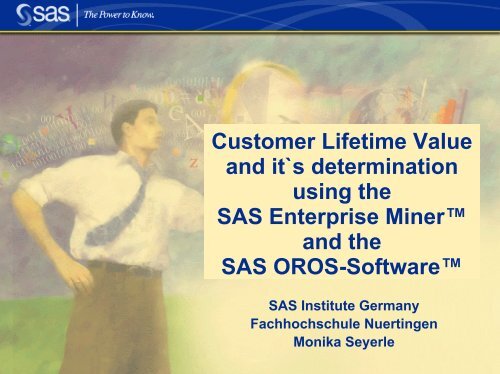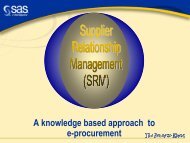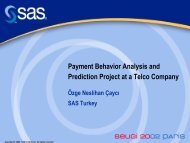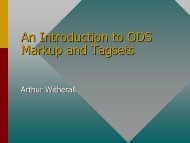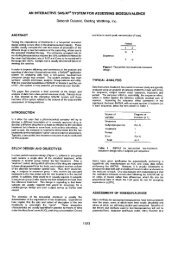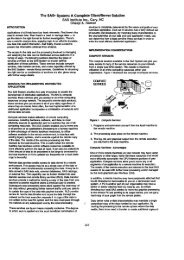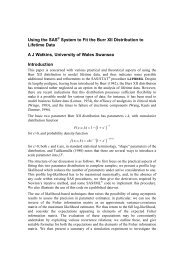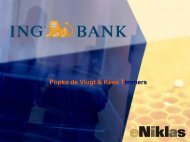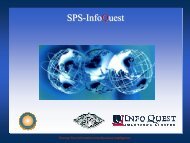Customer Lifetime Value in Insurance - sasCommunity.org
Customer Lifetime Value in Insurance - sasCommunity.org
Customer Lifetime Value in Insurance - sasCommunity.org
You also want an ePaper? Increase the reach of your titles
YUMPU automatically turns print PDFs into web optimized ePapers that Google loves.
Def<strong>in</strong>ition <strong>Customer</strong> <strong>Lifetime</strong> <strong>Value</strong>The <strong>Customer</strong> <strong>Lifetime</strong> <strong>Value</strong> is the net presentvalue of a customer. It considers the differencebetween the total amount of revenues from acustomer and the companies` expenses for thiscustomer dur<strong>in</strong>g the whole duration of relationship.Copyright © 2001 , SAS Institute Inc. All rights reserved.
Calculation of the CLVCLVkt T= ∑ ==t0Ekt−(1 + itAktt)=Present<strong>Value</strong>k k k kk kk k E2( ) 1 − A1E02 − A E0T − AE − A + + + ... +T12T(1 + i1)(1 + iFuture<strong>Value</strong>2)(1 + iT)CLV kE tA tkt(t=0)Ti= <strong>Customer</strong> <strong>Lifetime</strong> <strong>Value</strong> of a customer k= revenue from a customer k= expenses for a customer k= customer k= time period (t=0, 1, 2, …)= today= predicted duration of a customers relationship= <strong>in</strong>terest rateCopyright © 2001 , SAS Institute Inc. All rights reserved.
Run of the CLVCLV<strong>Value</strong>Present <strong>Value</strong>Future <strong>Value</strong>ProfitabilityPotentialPotential <strong>Value</strong>Present<strong>Value</strong>Period of predictiontimePotential <strong>Value</strong>todayEnd ofpredictionperiodCopyright © 2001 , SAS Institute Inc. All rights reserved.
CLV <strong>in</strong> <strong>in</strong>surance <strong>in</strong>dustry• Calculat<strong>in</strong>g the Present <strong>Value</strong>• Determ<strong>in</strong>ation of the potentials concern<strong>in</strong>g thefollow<strong>in</strong>g components:• Cross-Sell<strong>in</strong>g <strong>Value</strong>• Cancellation <strong>Value</strong>• Claim <strong>Value</strong>Copyright © 2001 , SAS Institute Inc. All rights reserved.
Present <strong>Value</strong> of an <strong>in</strong>surance customerPV = Premiums – costs of claim – (activity-based costs)Directly related to a customerCopyright © 2001 , SAS Institute Inc. All rights reserved.
Future <strong>Value</strong> of a customerAssumption: Predicted Time Period T=1 yearRisk adjustedrevenuesAdditionalrevenuesPredictedexpensesR –Cancel + CS –Claim-ABCFV=(1 + i )FV = Future <strong>Value</strong>R = revenuesCancel = a customer`s cancellation valueCS = a customer`s Cross-Sell<strong>in</strong>g valueClaim = a customer`s claim valueABC = activity-based costsi = <strong>in</strong>terest rateCopyright © 2001 , SAS Institute Inc. All rights reserved.
Determ<strong>in</strong>ation of the potentialsCancellation <strong>Value</strong>Probabilityof *cancellationExpectedproductrevenueCross-Sell<strong>in</strong>g <strong>Value</strong>*Probabilityof crosssell<strong>in</strong>gCross-Sell<strong>in</strong>grevenueProbabilityof caus<strong>in</strong>gan accidentClaim <strong>Value</strong>*ExpectedclaimamountCopyright © 2001 , SAS Institute Inc. All rights reserved.
Determ<strong>in</strong>e the components us<strong>in</strong>g theSAS Enterprise M<strong>in</strong>erCancellation <strong>Value</strong>Cross-Sell<strong>in</strong>g <strong>Value</strong>Claim <strong>Value</strong>Probability ofcancell<strong>in</strong>g *Expectedamount ofcancellationProbability ofbuy<strong>in</strong>g*ExpectedCross-Sell<strong>in</strong>gamountProbability ofclaim<strong>in</strong>g *Expected claimamountData M<strong>in</strong><strong>in</strong>gModelData M<strong>in</strong><strong>in</strong>gModelData M<strong>in</strong><strong>in</strong>gModelData M<strong>in</strong><strong>in</strong>gModelData M<strong>in</strong><strong>in</strong>gModelData M<strong>in</strong><strong>in</strong>gModelcomb<strong>in</strong>edFuture <strong>Value</strong> of a customerCopyright © 2001 , SAS Institute Inc. All rights reserved.
Copyright © 2001 , SAS Institute Inc. All rights reserved.Modell<strong>in</strong>g the Probabilityof Cross-Sell<strong>in</strong>g
Copyright © 2001 , SAS Institute Inc. All rights reserved.Modell<strong>in</strong>g the expectedCross-Sell<strong>in</strong>g amount
Comb<strong>in</strong>ation of all componentswhich determ<strong>in</strong>e the CLVSegmentation of Present <strong>Value</strong> versus Future <strong>Value</strong>Future <strong>Value</strong>Present <strong>Value</strong>Present <strong>Value</strong>: lowFuture <strong>Value</strong>: highCopyright © 2001 , SAS Institute Inc. All rights reserved.
Characteristics of the customerswith a low present valueand a high future valuem40= male peoplebetween 30 and40 yearsCopyright © 2001 , SAS Institute Inc. All rights reserved.
CLV based actionsFeedback-LoopHighPotentialKeep+Enhance! Cross-/Up-Sell<strong>in</strong>g! <strong>Customer</strong>RetentionProfitable<strong>Customer</strong>s<strong>Customer</strong>BaseLowPotentialKeep+Enhance! Repeat Purchase! LoyaltyUnprofitable<strong>Customer</strong>sHighPotentialEnhance+Keep! Cross-/Up-Sell<strong>in</strong>g! <strong>Customer</strong>RetentionLowPotentialcancel! Limit Service! Term<strong>in</strong>ation of therelationshipCopyright © 2001 , SAS Institute Inc. All rights reserved.
<strong>Customer</strong> <strong>Lifetime</strong> <strong>Value</strong> Management• Identify the determ<strong>in</strong>ants of the CLV concern<strong>in</strong>g a specificcompany• Calculate the Present <strong>Value</strong> and determ<strong>in</strong>e the potentialsby us<strong>in</strong>g the SAS Software• Segmentation of the customers concern<strong>in</strong>g the twodimensions: the customer`s Present <strong>Value</strong> and it`s Future<strong>Value</strong>• Determ<strong>in</strong>ate the perfect market<strong>in</strong>g-, sales- and servicesupportfor each customer accord<strong>in</strong>g to it`s particular CLV• Determ<strong>in</strong>ate the target profile of the special valuablecustomers and use it for the acquisition of new customersCopyright © 2001 , SAS Institute Inc. All rights reserved.
Thank you for your attention!contact: monika.seyerle@web.deCopyright © 2001 , SAS Institute Inc. All rights reserved.
Good afternoon ladies and gentlemen. I hope you have had a good lunch andyou are not too tiered now to follow my presentation.As you can see from the conference programme, I`m go<strong>in</strong>g to be talk<strong>in</strong>gabout the <strong>Customer</strong> <strong>Lifetime</strong> <strong>Value</strong> and it`s determ<strong>in</strong>ation.My name is Monika Seyerle and after study<strong>in</strong>g bus<strong>in</strong>ess adm<strong>in</strong>istration at theuniversity of Nürt<strong>in</strong>gen <strong>in</strong> Germany, I`ve done my f<strong>in</strong>al thesis <strong>in</strong> corporationwith SAS Institute Germany <strong>in</strong> Heidelberg.Beside my theoretical studies, the aim was also to determ<strong>in</strong>e the CLV forspecific <strong>in</strong>surance customers by us<strong>in</strong>g the SAS Software Enterprise M<strong>in</strong>erand the SAS OROS Software.I`d like to start by look<strong>in</strong>g at the theoretical determ<strong>in</strong>ation of the CLV. Then I`llmove on to show how you can <strong>in</strong>tegrate activity-based cost<strong>in</strong>g <strong>in</strong> the CLVconcept.At the end I`m go<strong>in</strong>g to show you an example how the CLV can bedeterm<strong>in</strong>ed for the customers of an <strong>in</strong>surance company us<strong>in</strong>g the SASSoftware.If there are any questions, I would be glad to answer them after mypresentation.1) First of all, I`d like to have a look at the Bus<strong>in</strong>ess strategies of a company.Several years ago, companies tried to acquire or to reta<strong>in</strong> as many customersas possible.Nowadays they often take another po<strong>in</strong>t of view: not the quantity of customersis the important th<strong>in</strong>g, but the quality of each customer, mean<strong>in</strong>g howprofitable each customer is.The strategies to acquire and to reta<strong>in</strong> as many customers as possible, don`ttake <strong>in</strong>to consideration that the less profitable customers are likely to bereta<strong>in</strong>ed as well.
But these less profitable customers consume the profit, which was ga<strong>in</strong>ed bythe highly profitable customers.The aim of the strategy “<strong>in</strong>creas<strong>in</strong>g customer`s profitability” is to acquire morevaluable customers with more effort, and to reta<strong>in</strong> valuable exist<strong>in</strong>gcustomers by treat<strong>in</strong>g them with more care and consideration.In this way, limited resources can be used especially for the acquisition andretention of highly valuable customers for a company.But who are now these valuable customers? The CLV helps to f<strong>in</strong>d outwhether a customer is of high or low value for a company.2) Let`s have a look at the customer Lifecyle.You will notice that a relationship between a customer and a company can bedivided <strong>in</strong>to several stages like: acquisition, <strong>in</strong>tensification, retention andrecovery or term<strong>in</strong>ation.This slide shows the Lifecycle of a typical customer.At the beg<strong>in</strong>n<strong>in</strong>g of a relationship there are often required high acquisitioncosts. At this stage the costs are almost always higher than the <strong>in</strong>comes. Theconsequence is, that there is often a loss at the beg<strong>in</strong>n<strong>in</strong>g of the relationship.Companies accept this loss because of the expected future purchases of acustomer, which compensate the losses from the beg<strong>in</strong>n<strong>in</strong>g.Assume, the profits of a customer will normally <strong>in</strong>crease with<strong>in</strong> the duration ofa relationship and decrease aga<strong>in</strong> from a specific po<strong>in</strong>t of time.The duration of a Lifecycle depends on the l<strong>in</strong>e of bus<strong>in</strong>ess and on thedifferent companies itselves.If you want to improve the profitability of a customer, you will try to maximizethe profits by <strong>in</strong>creas<strong>in</strong>g the <strong>in</strong>comes or by m<strong>in</strong>imiz<strong>in</strong>g the costs.Let`s have a look at how you can improve the Lifecycle of a customer.
- First of all, a more efficient acquisition of new customers should be triedto realise.- In the second stage better cross-, and up-sell<strong>in</strong>g activities for the rightcustomers should be created.- In the stage of retention, customer care activities should be <strong>in</strong>tensifiedto extend the duration of a customer`s Lifecycle.- In the last stage “Term<strong>in</strong>ation or Recovery” it is up to you/your turn togive up less valuable relationships or to recover customers with highpotentials.3) The question is: how can the CLV be <strong>in</strong>tegrated <strong>in</strong>to the Lifecycle and <strong>in</strong>what way it is possible to generate higher profits.- a more efficient acquisition of new customers is released by acquir<strong>in</strong>gthese customers, who have the same target profile as the highlyvaluable customers, with more effort. To know which of your customersare more valuable than others, it is important to set up a target profile.Then it is possible to acquire only these customers, who have the sameor a similar profile as your exist<strong>in</strong>g highly valuable customers.- To require a higher profit from your exist<strong>in</strong>g customers, it is necessaryto offer Cross- and Up-Sell<strong>in</strong>g-offers to those customers, who have ahigh probability to do Cross- and Up-Sell<strong>in</strong>g <strong>in</strong> the future.- Know<strong>in</strong>g that a specific customer has a high potential <strong>in</strong> the future, youcan specificly try to reta<strong>in</strong> or to recover him by <strong>in</strong>creas<strong>in</strong>g your customercare activities or offer<strong>in</strong>g him special products or offers.- <strong>Customer</strong>s with low potential <strong>in</strong> the future are to be treated with lowereffort. Sometimes it is better to cancel the whole relationship, <strong>in</strong>stead ofwast<strong>in</strong>g a lot of money for those less valuable customers.
The limited resources <strong>in</strong> a company can be used that way especially forhighly valuable customers, <strong>in</strong>stead of wast<strong>in</strong>g them for less valuablecustomers.4) Let`s have a look at the def<strong>in</strong>ition of the customer lifetime value:The customer lifetime value is the net present value of a customer. Itconsiders the difference between the total amount of revenues from acustomer, and the companies` expenses for this customer dur<strong>in</strong>g the wholeduration of a relationship.What does this mean <strong>in</strong> detail?5) Let`s move on to the components, which determ<strong>in</strong>e the CLV. You have todist<strong>in</strong>guish between quantitative and qualitative factors.- Quantitative factors can be measured directly and they concern thepast, as for example the revenues and costs of each customer <strong>in</strong> thepast.The sales volume, acquisition costs, direct costs and activity-basedcosts can be regarded as quantitative components. These componentscan be used to determ<strong>in</strong>e the present value of a customer.- Qualitative factors can`t be measured directly, because they concernethe future.Examples for qualitative factors are the Cross-or Up-Sell<strong>in</strong>g-Potential,the referral potential, the <strong>in</strong>formation potential or the op<strong>in</strong>ion leaderpotential.- The cross-Sell<strong>in</strong>g Potential deals with, how far a customer <strong>in</strong>tense tobuy new offered products from a company.- The reference potential considers referrals of other, new customersmade by a specific exist<strong>in</strong>g customer.
- The <strong>in</strong>formation potential considers the <strong>in</strong>formation a company getsfrom a specific customer, like <strong>in</strong>formation about defect products orth<strong>in</strong>gs, which should be corrected. This employee proposal systemhelps the company to save money and to improve its processes.- The op<strong>in</strong>ion leader potential considers customers, who are able tocanvass new customers.Look<strong>in</strong>g at this qualitative factors, a determ<strong>in</strong>ation of a future value can bereceived for each customerThe CLV is normally consider<strong>in</strong>g the revenues and expenses dur<strong>in</strong>g thewhole relationship of a customer.Instead of consider<strong>in</strong>g the whole relationship, with all the expected revenuesand expenses, which is quite difficult to determ<strong>in</strong>e, a specific period of timecan be set. This means that you just look at a certa<strong>in</strong> period of time, like forexample one or two years. Then you get a Future <strong>Value</strong> of a customer not forhis whole relationship, but for a specific certa<strong>in</strong> period of time, for example afuture value for the follow<strong>in</strong>g year.The CLV can be determ<strong>in</strong>ed by us<strong>in</strong>g the net present method, which will bedescribed <strong>in</strong> the next slide, where the calculation of the CLV will beconsidered.6) The CLV is composed of the present and the future value of a customer.The present value relates to the data out of the past. It can be calculated byreduc<strong>in</strong>g the expenses for a customer, from the revenues ga<strong>in</strong>ed through thiscustomer. As a result you get a present value for each customer concern<strong>in</strong>gtheir purchases and actions <strong>in</strong> the past.The future value can be calculated by discount<strong>in</strong>g the difference of future<strong>in</strong>comes and expenses to today`s moment of time.
But the determ<strong>in</strong>ation of a customer`s future value is not as simple asperhaps expected, because you don`t know exactly what the <strong>in</strong>comes of acustomer will be <strong>in</strong> the future and which costs are thereby <strong>in</strong>curred.As I mentioned before, it is very difficult to predict future <strong>in</strong>comes andexpenses for several years <strong>in</strong> advance. So it is more useful and even moreexact to observe a restra<strong>in</strong>ed period of time like one or two years.The follow<strong>in</strong>g concept will consider a period of time of one year, mean<strong>in</strong>g thatthe <strong>in</strong>comes and expenses will be predicted for the follow<strong>in</strong>g year.7) To illustrate how the present and the future value fit together <strong>in</strong> the CLV,let`s have a look at the follow<strong>in</strong>g graph.The present value considers the profitability of a customer <strong>in</strong> the past.The future value <strong>in</strong> contrast, focuses on the potential of a customer <strong>in</strong> thefuture. In case under consideration the future value is the potential value foreach customer <strong>in</strong> the follow<strong>in</strong>g year.Companies conf<strong>in</strong>e themselves <strong>in</strong> general to exam<strong>in</strong><strong>in</strong>g the present value oftheir customers.But it is precisely the determ<strong>in</strong>ation of their future potential, which is muchmore <strong>in</strong>terest<strong>in</strong>g for a company.By know<strong>in</strong>g the development of a customer, you can estimate if an<strong>in</strong>vestment <strong>in</strong> this customer will be profitable or not.A student for example, who possesses <strong>in</strong> general a low present value for acompany, is likely to have a high potential <strong>in</strong> the future.Especially <strong>in</strong> bank or <strong>in</strong>surance sectors, students get offered check accountsfor free with reference to their high potential <strong>in</strong> the future.But how is it possible to determ<strong>in</strong>e the present and the future value of acustomer?
8) To illustrate this po<strong>in</strong>t, let`s have a look at the <strong>in</strong>surance sector toexemplify how both of the values could be determ<strong>in</strong>ed.The present value for each <strong>in</strong>surance customer can be calculated out of their<strong>in</strong>comes and expenses <strong>in</strong> the past. These data are listed <strong>in</strong> a DataWarehouse, and a present value is quite easy to f<strong>in</strong>d.The future value of an <strong>in</strong>surance customer could be determ<strong>in</strong>ed by predict<strong>in</strong>ga cross-sell<strong>in</strong>g, a cancellation- and a claim value for each customer for thefollow<strong>in</strong>g year. At the end, these three components are comb<strong>in</strong>ed and ones<strong>in</strong>gle future value for each customer can be determ<strong>in</strong>ed.There are a lot of more components which could be important for othercompanies and sectors, but I would just like to focus on these three.9) Let me start by look<strong>in</strong>g at the present value of an <strong>in</strong>surance customer. Tocalculate the present value, the costs have to be taken away from the<strong>in</strong>comes <strong>in</strong> form of premiums.The biggest part of costs <strong>in</strong> an <strong>in</strong>surance company, are the costs foraccidents respectively the costs of claims. These costs can be allocateddirectly to a specific customer.Overhead costs, which are <strong>in</strong>curred by all customers, like adm<strong>in</strong>istrative coststo run a company, can`t be allocated easily to a specific customer. But withactivity based cost<strong>in</strong>g, which is gett<strong>in</strong>g more and more important forcompanies to save costs, it is gett<strong>in</strong>g possible to allocate overhead costs to aspecific customer, accord<strong>in</strong>g to the activities a customer takes up.10) I don`t want to consider activity-based cost<strong>in</strong>g <strong>in</strong> detail, but I will just giveyou an overview how the overhead costs of a cost center can be allocated toa specific customer.
To succed this aim, it is necessary to use a software like the SAS OROSSoftware. Without this software it is much more complicated and by us<strong>in</strong>g thesoftware you save a lot of time and money.Let`s have a look at the SAS OROS Software. We will regard the cost centerMarket<strong>in</strong>g. I`ve created a model with the aim to allocate overhead costs, likethe total amount of salaries, to specific customers, accord<strong>in</strong>g to whatprocesses or activities are necessary to care for a customer.First of all, the total amount of salaries for the employees, work<strong>in</strong>g <strong>in</strong> the costcenter Market<strong>in</strong>g, is allocated to certa<strong>in</strong> special processes. These processesare activities <strong>in</strong> a cost center, like for example “send<strong>in</strong>g out mail<strong>in</strong>gs” or“do<strong>in</strong>g advertisement”.These activities <strong>in</strong> a cost center can be put together <strong>in</strong> a ma<strong>in</strong> process like “toattract new customers”. These ma<strong>in</strong> processes group together severalactivities from different cost centers.To simplify the concept, I have classified the customers <strong>in</strong>to different groupsaccord<strong>in</strong>g to the time they are already <strong>in</strong> the company: there are newcustomers, develop<strong>in</strong>g customers and exist<strong>in</strong>g customers.- new customers are <strong>in</strong> the company for less than one year- develop<strong>in</strong>g customers are from one to three years and exist<strong>in</strong>gcustomers for longer than three years with the company.Accord<strong>in</strong>g to this, the costs of the ma<strong>in</strong> processes can be allocated tocustomer categories. For each customer category you will then f<strong>in</strong>d differentcosts.A new customer is <strong>in</strong> general more expensive than a longtime exist<strong>in</strong>gcustomer.
11) In this slide you can see an example of different ma<strong>in</strong> processes and thecosts of each ma<strong>in</strong> process. These costs can be allocated to a specificcustomer, every time a customer uses this process.For example the costs for the ma<strong>in</strong> process “order transaction” can beallocated to a specific customer, every time the customer takes an order.12) The second step to determ<strong>in</strong>e the CLV is the future value. The potentialof an <strong>in</strong>surance customer can be calculated by us<strong>in</strong>g the follow<strong>in</strong>g formula.The future value is composed of risk-adjusted revenues, of additionalrevenues through cross-sell<strong>in</strong>g, and of predicted expenses <strong>in</strong> form of claimand activity-based costs.Let`s have a detailed look at these components:- risk-adjusted revenues are premiums, which are received through aspecific <strong>in</strong>surance product reduced of the cancellation value for thisproduct.- Additional revenues is the additional money a company gets from acustomer because of offer<strong>in</strong>g him additional cross-sell<strong>in</strong>g products.- Predicted expenses are the predicted claim costs and the activity-basedcosts, which are estimated for the follow<strong>in</strong>g year.13) To determ<strong>in</strong>e the future value three components are to be considered: thevalue of cancellation, the claim value and the cross-sell<strong>in</strong>g value.These values can be predicted for the follow<strong>in</strong>g year by multiply<strong>in</strong>g theprobability of an event by the expected amount of money for each product.For example: the value of cancellation of a specific product is determ<strong>in</strong>edthrough the probability that a customer will cancel this product <strong>in</strong> the follow<strong>in</strong>gyear, multiplied by the amount of money, which gets lost through thiscancellation.14) The calculation of the future value will be clarified by look<strong>in</strong>g at thefollow<strong>in</strong>g example. It is assumed that a customer possesses two <strong>in</strong>surance
products, for which he has to pay different premiums. For the car <strong>in</strong>surance,he has to pay 1500€, for the home <strong>in</strong>surance 400€.It can be predicted, that he will cancel the car <strong>in</strong>surance with a probability of0.3 and the home <strong>in</strong>surance with a probability of 0.6. These probabilities aremultiplied by the correspond<strong>in</strong>g amounts of premiums for the products.For each product a value of cancellation can be determ<strong>in</strong>ed.Tak<strong>in</strong>g this example, the value of cancellation for the car <strong>in</strong>surance is 450€and for the home <strong>in</strong>surance 240€.Additionally, it can be predicted that a customer will take a new life <strong>in</strong>surance<strong>in</strong> the follow<strong>in</strong>g year, with a probability of 0.5. It will be expected that the life<strong>in</strong>surance will br<strong>in</strong>g <strong>in</strong> 1000€.Multiply<strong>in</strong>g the probability, that a customer will take this new product by theexpected amount of money for this product, you`ll then get a Cross-Sell<strong>in</strong>gvaluefor each product. In this example for the life <strong>in</strong>surance a value of 500€.Further you can determ<strong>in</strong>e a value of claim for each product a customerpossesses, through multiply<strong>in</strong>g the probability of a claim with<strong>in</strong> a specificproduct by the expected amount of money for the claim. For each productyou`ll then get a value of claim.In addition to this, a value of claim can also be determ<strong>in</strong>ed for additionalproducts through Cross-sell<strong>in</strong>g, like for the life <strong>in</strong>surance or the motorbike<strong>in</strong>surance.The claim values for each product not <strong>in</strong> possession of a customer yet, canalso be determ<strong>in</strong>ed by multiply<strong>in</strong>g the probability that a customer will draw onthis product (for the life <strong>in</strong>surance 0.5), by the predicted probability of anexpected claim (for the life <strong>in</strong>surance 0.01), by the expected amount ofmoney for a claim (for the life <strong>in</strong>surance 20000€).The activity-based costs are found with the SAS OROS Software and the<strong>in</strong>terest rate of 8 per cent is assumed.
All components were <strong>in</strong>serted <strong>in</strong> this formula on the bottom and the wholeterm was discounted to today`s po<strong>in</strong>t of time.In case under consideration, we will get a potential value for this specificcustomer of 790.74€.15) But how can the specific values be determ<strong>in</strong>ed?As I mentioned before, the three values “value of cancellation”, “Cross-Sell<strong>in</strong>g<strong>Value</strong>” and “claim value” are calculated by multiply<strong>in</strong>g the probability by theexpected amount of money.For each target variable, mean<strong>in</strong>g the probability and the expected amount, Ihave created a data m<strong>in</strong><strong>in</strong>g model with the use of SAS Enterprise M<strong>in</strong>er.With the help of this software it was possible to f<strong>in</strong>d out a customer`s specificvalue for each of the six target variables.All the models with the different values ended up <strong>in</strong> an overlapp<strong>in</strong>g M<strong>in</strong><strong>in</strong>gmodel, where f<strong>in</strong>ally the potential of each customer was calculated.16) Let me clarify this po<strong>in</strong>t by consider<strong>in</strong>g the “Cross-Sell<strong>in</strong>g-<strong>Value</strong>”.First of all, I`ve created a model for the target variable “Cross-Sell<strong>in</strong>g-Probability”. The aim was to determ<strong>in</strong>e a probability, that a customer will buyCross-Sell<strong>in</strong>g products <strong>in</strong> the follow<strong>in</strong>g year. Therefore the SAS EnterpriseM<strong>in</strong>er is essential. Based on historical data, the SAS Enterprise M<strong>in</strong>erdeterm<strong>in</strong>es components, which have an impact on the cross-sell<strong>in</strong>gprobability. In this example the premiums for the life <strong>in</strong>surance, thecancellation probability and the age of a customer has an impact on theCross-Sell<strong>in</strong>g probability.17) Correspond<strong>in</strong>g to this, I`ve created a second model for the target variable“Cross-Sell<strong>in</strong>g amount”. Based on historical data, variables with strong impacton the Cross-sell<strong>in</strong>g amount were discovered.For example the total premiums <strong>in</strong> a year, the premiums for the life <strong>in</strong>suranceand the amount of claims have an impact on the Cross-Sell<strong>in</strong>g amount.
After hav<strong>in</strong>g found these impacts, the SAS Enterprise M<strong>in</strong>er automaticallycalculates a modelled value, based on this historical data and impacts, for thefollow<strong>in</strong>g year for each customer.18) All the different models for the six target variables were comb<strong>in</strong>ed <strong>in</strong> anoverlapp<strong>in</strong>g model, where the present value of a customer was calculatedand the future value was predicted.Hav<strong>in</strong>g found two values for each customer, the present and future value, I`vecreated a portfolio with these two dimensions. All the customers with theirdifferent values could be <strong>in</strong>serted <strong>in</strong> the portfolio.Divid<strong>in</strong>g the customers <strong>in</strong>to different segments, accord<strong>in</strong>g to their present andfuture value, you will notice that <strong>in</strong> this example there are many customerswith middle present, but also with middle future values.Let`s consider a specific segment. For example this one, where the customerpossesses a low present and a high future value.19) Look<strong>in</strong>g at this segment, you will f<strong>in</strong>d out different characteristics of thesecustomers. There are especially male persons between 30 and 40 years <strong>in</strong>this segment with low present and high future value.20) Accord<strong>in</strong>g to these characteristics you can derive suitable actions fortreat<strong>in</strong>g customers differently.For example currently profitable customers with high future potential shouldbe tried to reta<strong>in</strong> with more effort.Offer<strong>in</strong>g them special Cross- and Up-sell<strong>in</strong>g offers and <strong>in</strong>volv<strong>in</strong>g them <strong>in</strong>tospecial customer care actions can enhance their satisfaction and lengthentheir relationship to a company.
21) Let me summarise briefly what I`ve said by consider<strong>in</strong>g the whole CLV-Management, which consists of different steps:- First, you have to determ<strong>in</strong>e the specific components, which areimportant for a company to determ<strong>in</strong>e the CLV- Next, the present value and the future potential of each customer isdeterm<strong>in</strong>ed by us<strong>in</strong>g the SAS Software OROS and Enterprise M<strong>in</strong>er- Consequently, the customers can be classified <strong>in</strong>to different segmentsaccord<strong>in</strong>g to their present and future value- After that, different market<strong>in</strong>g-, sales-, and service-actions can bederived for each customer segment- At last, it is important to discover the characteristics of your highlyprofitable customers. As you know this target profile, it can be used toacquire more likely valuable new customers.Thank you for your attention and if you have any further questions please feelfree to contact me per e-mail or ask me now.


